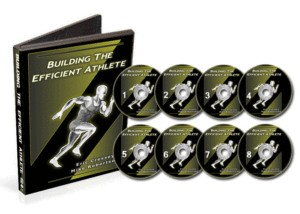Newsletter 161
I have the normal weekly newsletter posted below, but first a quick announcement: Mike Robertson, Bill Hartman, and I just filmed a new DVD set! Those of you who have enjoyed all of our products individually can now see what happens when the three of us collaborate. For more information, check out today’s blog post: A Sneak Peak at the New Project.
The Law of Repetitive Motion: Part 2
In last week’s newsletter, I talked about the first three component of the law of repetitive motion: “I” (injury/insult), “N” (number of repetitions), and “F” (the force of each repetition, expressed as a percentage of maximal strength).

This week, I’ll discuss the “A” and the “R” of this equation. To begin, amplitude, stated simply, is range of motion. If we spend our entire lives in limited ranges of motion, we run into problems.
Obviously, this refers to those who sit too often and too long – particularly in poor postures. I’m a big believer that the best posture is the one that is constantly changing, so I always encourage people to try to get up and move around every 20-30 minutes whenever possible. If not, I love the idea of simply “shuffling” positions at your computer. Complement this constant fluctuation of posture with some good training to open up the hips and thoracic spine, and strengthen the upper back and glutes, and you’ll find that being stuck in a job with a small amplitude is a “manageable” problem.
Amplitude can also refer to only doing certain exercises in the gym, particularly those who exercise through a partial range of motion. It might be people who simply press too often and pull too infrequently, or those who perform a lot of bilateral exercises, but nothing unilateral. We aren’t just talking about ranges of motion at the joints; we are also talking about the muscles recruited and type of muscle action – concentric, eccentric, isometric – that takes place.
Lastly, working at a specific task for extended periods of time can be a huge issue for some. Just ask musicians, factory line workers, and even baseball pitchers. These issues can all impose huge asymmetries that must be addressed both directly (soft tissue work, flexibility training) and indirectly (training the contralateral side, or just exposing the individual to a broader excursion of movement outside this specific task).
So, all that in mind, improving amplitude is all about increasing range of motion in one’s daily life. Of course, this must be specific range of motion. You wouldn’t, for instance, want to increase lumbar spine range of motion in most back pain patients, but you would want to optimize hip and thoracic spine mobility.
Rest, the “R” in our equation, is pretty straight-forward: if a tissue is angry, you need to give it time to settle down. However, just stopping all exercise isn’t always the best bet.
Often, it’s simply a matter of keeping the stress on the tissue below its capacity for loading. As a great example, a lot of manual therapists with whom I’ve worked actually like people to go out and lightly load tissues that have just been worked in order to teach the tissue to “deform” properly. For instance, I got a little “Graston Loving” on my biceps a while back, and spent the rest of the day lightly loading the tissues and doing some prolonged stretching sets. It worked like a charm.
Taking it a step further, though, much of the time, it’s about redistributing stress. For instance, someone with anterior knee pain may not be able to do a more quad-dominant squat, but instructing that same lifter to sit back into the glutes and hamstrings more can markedly take down the stress on the anterior knee. Sure, it changes the muscular recruitment of the exercise, but the lifter derives great benefit and keeps the loading on the affected tissues below capacity. And, in this particular case, he’s strengthening the posterior chain muscles that almost always help to prevent anterior knee pain in the first place.
That wraps up our look at the law of repetitive motion. It’s certainly not an exhaustive review, but my hope is that it got you thinking just enough to consider how this law applies to the issues you see on a daily basis, as well as those you want to prevent from ever reaching threshold. For more information, check out the Building the Efficient Athlete DVD Set.
New Blog Content
Random Friday Thoughts
The Who-What-When-Where-Why of Flexibility Training
In the Presence of Greatness
Have a great week!
EC
Sign up for our FREE Newsletter today and and receive this deadlift technique video!





